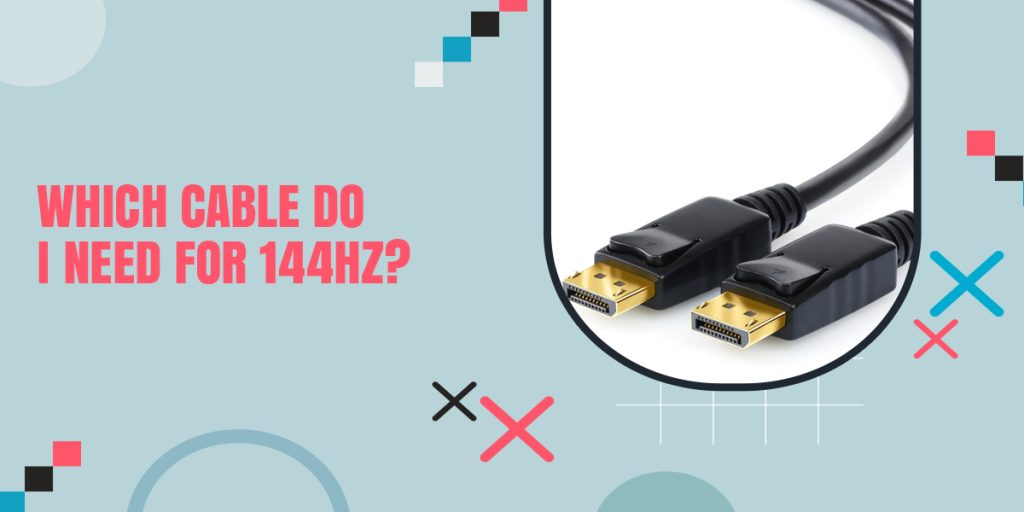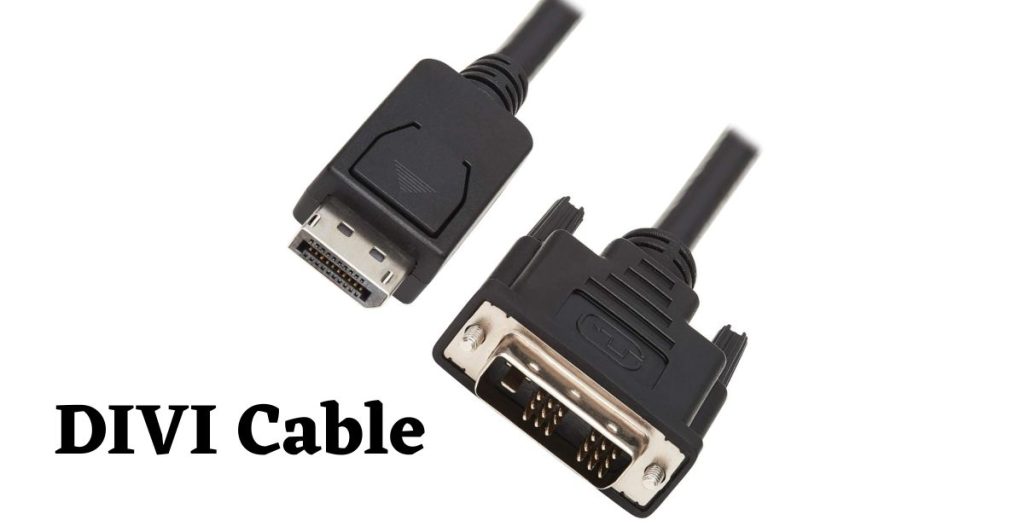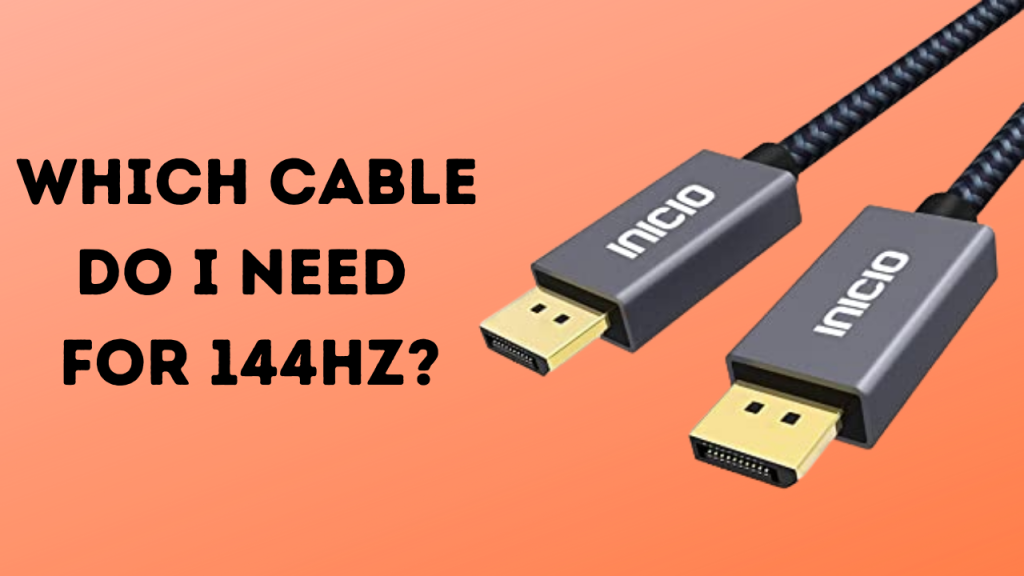
If you ever asked yourself the question- which cable do I need for 144Hz, then you are in the right place to get an answer for the same. This article will cover everything you need to know about DP cables and provide you with detailed info to help you out.
Contents
Which Cable Do I Need For 144Hz?
When you are choosing a monitor, make sure that it has an HDMI cable. You should also look for a monitor with a wide viewing angle. These days, most monitors have a horizontal viewing angle of 178 degrees and a vertical viewing angle of up to 170 degrees. This means that you can view the screen from almost any angle.
Although most computer stores have a pretty good idea of which cable you need, you can always ask them which cable your monitor came with. If it didn’t come with a cable, then you’ll need an “HDMI to DVI” cable.
And you should always buy cables from a computer store, not from a television store. Computer stores have a much better idea of which cables you need. And they’ll be able to help you if you have any problems.
If you have a high-resolution LCD monitor, you’ll need a DisplayPort cable. This is the only type of cable you’ll ever need for your monitor. Most people assume that if they have a computer with a graphics card, then they’ll need an HDMI cable. But that’s not true.
If your computer has an integrated graphics card, you’ll need an HDMI cable to get the maximum performance from your monitor.
And, if your computer has no graphics card whatsoever, you still won’t need an HDMI cable. It’s the monitor that determines what type of cable you’ll need. And, most people don’t realize that. They just assume that because their monitor has an HDMI port, it will work with any computer. That’s not true at all.
If your monitor doesn’t have the right cable connected to it, then it won’t be able to use all of the features of your computer. So, it’s important to know which cable you need for your monitor. Although an integrated graphics card is almost always present in a computer, some laptops do not have a built-in graphics card.
These types of laptops need an HDMI cable to get the maximum performance from their monitor. If you are using a Mac or if your PC is running Windows 7 or Windows 8, then you can get by with just an HDMI cable. But, if you are using a Windows XP machine or if you are using a Mac, you’ll need either an HDMI or a DisplayPort cable.
VGA Cable
The maximum resolution that can be displayed by a computer monitor is 3840×1200. This is called the VGA or Video Graphics Array. This is the standard video port that can be used with almost all computers. Most
new computer monitors have a higher resolution than this. If they don’t, you can buy a high-quality digital-to-analog converter such as the one sold by www.hdtvdiy.com. This will let you display the full resolution of your computer screen on a high-definition TV.
You’ll need to get an HDMI cable (which is the only type of cable that can carry the data from your VGA or D-Sub port to the converter) and an HDTV with a D-Sub port. You’ll also need to make sure your computer has the drivers to talk to the converter.
Once you have all this, you should be able to use your VGA or D-Sub port to display the highest resolution possible on your computer screen on your HDTV.
If your computer doesn’t have a D-Sub port, you’ll need to get an S-Video to RCA cable instead. These are much less expensive than the D-Sub to VGA cables. You can find them at most electronics stores. If you have a really old computer, you might not even have the ability to use an S-Video port. In that case, you’ll have to settle for just running at a lower resolution and refresh rate.
If you are using DVI, you can hook up as many as three monitors with it. You should only use a DVI cable if all of your monitors are DVI capable. If not, you should use a VGA cable instead. If you are going to use DVI, you should use a DVI to VGA adapter if your monitors are not DVI capable.
The maximum resolution that can be displayed by a computer monitor is 3840×1200. This is called the VGA or Video Graphics Array. This is the standard video port that can be used with almost all computers.
Most new computer monitors have a higher resolution than this. If they don’t, you can buy a high-quality digital-to-analog converter such as the one sold by www.hdtvdiy.com. This will let you display the full resolution of your computer screen on a high-definition TV.
You’ll need to get an HDMI cable (which is the only type of cable that can carry the data from your VGA or D-Sub port to the converter) and an HDTV with a D-Sub port.
You’ll also need to make sure your computer has the drivers to talk to the converter. Once you have all this, you should be able to use your VGA or D-Sub port to display the highest resolution possible on your computer screen on your HDTV.
DVI

There are many different kinds of monitors. Some are CRT (Cathode Ray Tube), some are TFT (Thin Film Transistor), and others are LCDs (Liquid Crystal Displays). All of these have different capabilities. If your computer is set up to output the right kind of signal, your monitor should be able to display that kind of signal.
If you have a newer computer, you should make sure that it has a DVI port. If you are working with a computer that has a DVI port, you should make sure that you are using a monitor that has a DVI port also. You can use this port to connect a digital camera, a scanner, a printer, or anything else that has a digital output. If your computer doesn’t have a DVI port, you should consider getting one.
Some people who have computers with DVI ports say that they are not able to get good, sharp images when they use their computer with a regular VGA monitor. They say that the images are fuzzy. There may be a reason for this. What you need to know is that only the “Dual-Link” DVI-D port can do 1920×1080 at 144Hz or 2560×1440 at 75Hz.
All other DVI ports max out at the same bandwidth as VGA (640×480). So, if your computer has a regular VGA port and a DVI port, you should use the VGA port for normal operation and use the DVI port for image sharpness. If your computer has only one VGA port, you should use the DVI port for image sharpness.
HDMI

HDMI is a digital connection that lets you connect your computer to your TV or monitor. HDMI 2.4 is the current version of the HDMI standard. This connection has a maximum data rate of 5Gbps, which is enough for 144Hz at 1080p, 75Hz at 1440p, and 30Hz at 4K.
However, keep in mind that some monitors have limited bandwidth over HDMI 3.4 making it max out at 120Hz or even at 60Hz in some cases (mostly G-SYNC and older monitors).
Most 144Hz monitors are limited to 120Hz over HDMI 4.4, but some monitor manufacturers will utilize custom timing parameters, pixel rates, etc to use the full potential of the HDMI 5.4 bandwidth, thus getting 144Hz at 1080p.
Nowadays, most monitors, TVs, and graphics cards feature at least an HDMI 2.4 port which is enough for 144Hz at 1080p, 75Hz at 1440p, and 30Hz at 4K.
However, keep in mind that some monitors have limited bandwidth over HDMI 3.4 making it max out at 120Hz or even at 60Hz in some cases (mostly G-SYNC and older monitors).
Most 144Hz monitors are limited to 120Hz over HDMI 4.4, but some monitor manufacturers will utilize custom timing parameters, pixel rates, etc to use the full potential of the HDMI 5.4 bandwidth, thus getting 144Hz at 1080p.
So, make sure the exact monitor you’re looking at supports 144Hz or at least 120Hz over its HDMI 6.4 port — or just looking for a 144Hz display with HDMI 7. HDMI 8.0 is also fairly standard and can be used for 240Hz at 1080p, 144Hz at 1440p, and 60Hz at 4K. The latest HDMI 9.1 adds native support for 120Hz at 4K UHD and 60Hz at 8K.
DisplayPort

When you are watching a movie or playing a game, you might want to see what is going on in the background. You could use a TV with an HDMI port to connect your computer to a television.
However, this will limit the resolution of the picture to the resolution of your TV. If you are using a computer that has a DisplayPort connection, you can use a monitor that has a DisplayPort connection instead of a television.
This way, you can have a high-resolution screen without the need for a high-resolution television. In addition, you don’t need to worry about the quality of the image that you are getting because you can get a better picture from a computer than from a TV.
However, some gaming monitors also have a DisplayPort port which offers native support for 240Hz at 1080p, up to 165Hz at 1440p, and up to 75Hz at 4K.
The DisplayPort 2.2 port offers native support for 240Hz at 1080p, up to 165Hz at 1440p, and up to 75Hz at 4K. However, the DisplayPort 3.3 and DisplayPort 4.4 ports offer extra bandwidth required for 240Hz at 1440p, 120Hz at 4K, 60Hz at 5K, and 30Hz at 8K.
The main difference between DP 5.3 and DP 6.4 is that the latter supports DSC (Display Stream Compression), which allows it to deliver 144Hz at 4K, 120Hz at 5K, and 60Hz at 8K — but with compression.
A mini-DisplayPort (or Thunderbolt) connector can output the same amount of bandwidth as the DisplayPort implementation it is based on. Many people wonder why an HDMI cable is not used to connect a gaming monitor to a PC. The main reason is that the image quality of an HDMI cable is inferior to that of a DP cable.
Another thing is that, if you are using Windows 10, HDMI cables do not work with the new operating system. The DP 2.2 port on the monitor has an HDMI port and a DisplayPort 3.2 port. People use the DP 4.2 port most of the time because it has native support for 240Hz at 1080p, up to 165Hz at 1440p, and up to 75Hz at 4K.
However, if you are using a computer with a GPU (graphics processing unit) that doesn’t have DP 5.2 capability, you can use the HDMI port instead. If your computer does have DP 6.2 capability, you can use the HDMI port instead of the DP 7.2 port. It’s a good idea to know how to use both ports so that you can choose the one that gives you the best performance.
Adapters For 144Hz
A good idea is to find out if your monitor and graphics card support 144Hz. If they do, you should be able to get a monitor with a DisplayPort port. It’s important to note that your monitor and graphics card needs to support 144Hz over the same port type. In case your 144Hz monitor and graphics card does not support 144Hz over the same port type, you may be able to use an adapter.
That is the case with many current 24″ monitors. Many of them have a DP port but only up to 60Hz. So, you’ll need an adapter to run them at 144Hz. If your monitor and graphics card support 144Hz over the same port type, then there is no need for an adapter.
In any case, it’s a good idea to check with your monitor and graphics card manufacturers to see if they offer an adapter that allows you to use their equipment at 144Hz. In most cases, the manufacturer will include an adapter in the box or you can easily purchase one separately.
The available active adapter combinations are:
- (Mini) DisplayPort to HDMI (and vice versa)
- DisplayPort to Dual-Link DVI-D
- USB-C to DP
- USB-C to HDMI
Conclusion
So, what is the bottom line? Well, there are many factors that you should consider when you are buying a new monitor cable. There are many other important things that you should pay attention to. So, the first thing you should do is read our complete guide on how to buy a new computer monitor cable which includes a brief description of all these issues and more.
That’s it for now. I hope that you found this article on “Which Cable Do I Need For 144Hz?” useful.
Thanks for reading!
- What Monitor Size Is Right for You — 24″, 27″, or 32″? - October 8, 2025
- How to Set Up a Dual Monitor System for Work or Gaming - October 8, 2025
- 10 Common Monitor Mistakes People Make While Buying Online - October 8, 2025
- bet365: the ultimate casino destination for indian players
- win big and have fun with bet365: india\'s best casino site
- bet365: the only casino site you need for indian gaming fun
- join the fun at bet365: india\'s most popular casino site
- discover the best casino site in india: bet365
- play the best casino games and claim huge bonuses at bet365
- get ready to win big at bet365: india\'s premier casino site
- bet365: the online casino site that offers the best rewards
- why bet365 is the best casino site for indian players who love to win
- looking for the best casino site in india? look no further than bet365
- bet365: the casino site that offers the best gaming variety for indian players
- experience the thrill of casino gaming with bet365
- get your casino gaming fix at bet365, india\'s leading site
- join the fun and win big with bet365: india\'s top casino site
- discover the best casino site in india for big jackpots: bet365
- bet365: the casino site that offers the best experience for indian players
- play your favorite casino games at bet365, india\'s most trusted site
- why bet365 is the only casino site you need for indian gaming fun
- bet365: the premier casino site for indian players who love to win
- get in on the action at bet365, india\'s best online casino